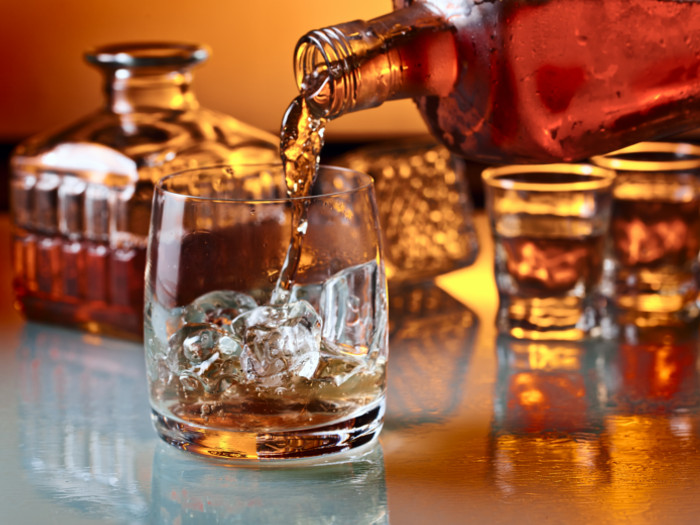Rye whiskey is not the most popular variety of this alcohol, but it does have a unique quality that makes it well worth drinking. It’s one of America’s original spirits; so let’s find out more.
What is Rye Whiskey?
Rye whiskey is a historic American alcohol that is made from 51% rye and aged in charred, oak barrels. It originated in the northeastern United States in the 1700s. The presence of rye grain in the distillation process makes it unique among whiskeys. Rye grain is known for its sharp taste, pleasant and slightly spicy flavor, as well as its distinctive aroma.
Studies conclude that the distillation process removes all traces of gluten. However, people do occasionally report symptoms of gluten sensitivity from drinking neutral grain alcohol. Pay attention to your own body’s reaction, particularly if you have Celiac disease. [1]
Nutrition Facts: In terms of nutrition, rye whiskey contains about 70 calories per ounce. This is comparable to other spirits, like vodka or rum, both of which possess an average of 64 calories.

Rye whiskey is a historic American alcohol that is made from 51% rye. Photo Credit: Shutterstock
Types
There are two classifications of rye whiskey, each with different regulations:
- American rye whiskey: This is highly regulated. The standards produce fine rye whiskeys enjoyed the world over.
- Canadian rye whiskey: The makers are far less regulated, resulting in a broad range of styles under the single classification.
Rye Whiskey vs Bourbon
Let us take a look at the differences between rye whiskey vs bourbon.
Bourbon
- At least 51% corn in the mash
- Made in the United States
- Aged in new charred oak barrels
- Bottled at 40% ABV or higher
- Tastes slightly sweet, with warm notes of vanilla
American Rye Whiskey
- At least 51% rye in the mash
- Production is in all other ways identical to bourbon
- Slightly dry and spicy, with subtler sweet aromas
Canadian Rye Whiskey
- Blended whiskey. Some have 0% rye, while others have 100% rye
- Must be aged for at least 3 years
- You may find some to be light and smooth tasting, but others are quite intense! [2]
How to Make Rye Whiskey?
This is a helpful guide for individuals to make rye whiskey. However, alcohol consumption, if done in an excessive manner, can lead to short-term health risks such as violence and injuries as well as long-term health risks such as addiction, alcohol abuse, and chronic diseases. According to the Centers for Disease Control and Prevention, people who should not drink alcohol include women who are pregnant, individuals younger than 21 years of age, and people who are recovering from alcoholism or cannot control the amount they drink. Also, it should be avoided by people who are planning to drive or any other activity that required focus, alertness, and skill. [3]
Different countries have different legal guidelines on alcohol consumption. According to The 2015-2020 Dietary Guidelines for Americans, if alcohol is consumed, it should be done in moderation. The guidelines define moderate drinking as up to 1 drink per day for women and up to 2 drinks per day for men, which applies to adults of legal drinking age. [4]
Keeping these guidelines in mind, let us look at the recipe for smoky rye whiskey.

Smoky Rye Whiskey Recipe
Ingredients
- 6 lb rye malt
- 3.5 lb flaked corn
- 0.5 lb malted barley
- 1 tsp acid blend
- 1 tsp gypsum
- 1 tbsp distiller's yeast
- 5 gallons water
Instructions
- Put all the rye, corn, barley, acid blend, and gypsum in a large mesh bag and mix them using a large wooden spoon or ladle
- Heat the water up to 165ºF and pour it into a large insulated container. The container should be big enough to hold the water as well as the soaked grain mix.
- Tie the top of the mesh bag and immerse it in the hot water. Make sure the container has a tight-fitting lid. Let the grains steep for 60 to 90 minutes. You can stir it every 20 minutes.
- Let the temperature cool to 70ºF. This liquid is the wort.
- Now comes the fermentation of the wort. Transfer it to a fermenter and add the yeast. You can opt for open fermentation or closed.
- The wort will typically take a week to ferment. It may take less time under warm temperatures. You will know the wort has completed fermenting when it stops bubbling.
- Filter the liquid using cheesecloth to take out any solid particles. The liquid is now known as wash.
- Put the wash in a still and heat it slowly till it reaches 140ºF. This may take up to an hour.
- Once the temperature reaches 140ºF, turn on the condenser. The alcohol will vaporize and collect in the condenser.
- Make sure to discard the first still you will get. It is toxic. It is the first quarter cup you will get from the distiller.
- Keep the temperature at 175º to 185ºF and collect small batches from the condenser.
- When the temperature reaches 205ºF, discard the remaining liquid. You should be able to get 1 to 2 gallons of liquid.
- Store the whiskey in wooden oak barrels for aging. Let it age for 1-3 years and then enjoy it!

Notes
How to Drink?
- Enjoy neat or over ice.
- Use in classic cocktails for a dryer version of a Manhattan or an Old Fashioned.

